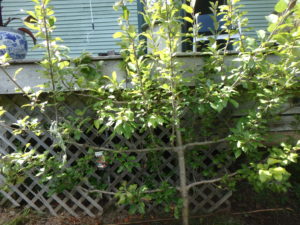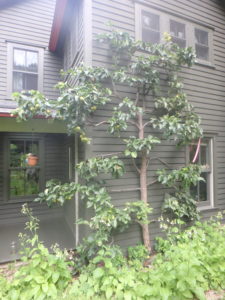Espalier Fruit Trees
When traveling in France and England I have often admired the fruit trees that have been pruned and trained to stay low and follow a wall or building. Their branches, like the extended arms of a scarecrow, travel horizontally – and are often loaded with fruit. I have wanted to try training a tree like this, a form called “espalier”. The word espalier is French, and comes from Italian meaning “something to rest the shoulder against”. It has come to mean not just the support, but the tree itself.
Trees in the espalier form are, essentially 2-dimensional. The branches are usually tied to wires or bamboo poles, often a foot or so in front of a wall. Branches growing towards or away from the wall are pruned off, as are most vertical branches. They save space and keep fruit low for easy picking. Walls protect the trees from high winds, and often reflect sunshine and heat to hasten ripening.
I was delighted to find an espalier apple tree for sale at Gardeners Supply Company in Lebanon, NH. Someone had already done a lot of the work training it for me, though it had many small water sprouts (shoots) that needed to be cut away.
My tree stands about 6 feet tall and has 3 pairs of parallel horizontal branches. Not only that, the branches are from three different varieties of apple – Zestar, Sweet 16 and Honey Crisp. That’s right, the branches were grafted on to the main stem so that, if all goes well, the tree will produce 3 different flavors of fruit.
Soon after planting my tree I heard about a workshop on espalier techniques, and I decided to go. Margaret Roach, a well-known author and blogger (www.awaytogarden.com) in Copake Falls, in upstate New York, was opening her gardens to the public through the Garden Conservancy, and she had asked Lee Reich, a well-known garden writer, to teach a class on espalier fruit trees. Lee is also the author or many books, including the best book on pruning that I have seen, The Pruning Book.
Lee began by explaining how plant hormones control growth and fruiting. It is essential to understand this if you wish to create an espalier, or even to prune a fruit tree to the size and shape you want.
The tallest branch on a tree produces plant hormones called auxins that control growth, branching and flowering (and hence fruit production). If you cut off the tallest part of the tree, the apical tip, a tree is more likely to produce side branches, and these tend to be more fruitful and less vigorous. Vertical branches such as watersprouts rarely produce fruit. They seem to want to grow fast and tall, competing with the leader, or tallest stem on the tree. In general, the horizontal branches of espalier trees should produce lots of fruit.
Lee Reich explained that some fruit trees do better than others when creating an espalier tree. Asian pears do wonderfully, and are almost always a success. But we are much farther south than England and northern France where espaliers do so well. We are at about the level of Madrid, and creating espalier is tougher for us. No, we can easily shape our trees in the form of espalier, but getting them to flower and fruit is tougher- our length of day is different.
There are apple trees that bear on fruit spurs – little gnarly branches just 2 or 3 inches long. Others produce fruit mainly on the tips of branches. Spur-type varieties are the best candidates for espalier. Macintosh is a spur-type apple, and there is one that is even better, MacSpur. Anything with “spur” in the name is good, according to Lee Reich. But other spur-type apples include Zestar, Red Delicious, Honeycrisp, Jonagold, Fuji, Jonathan, Chieftain and Winesap.
The tree I bought has no fruit spurs as yet. And when I bought it, it had lots of watersprouts growing straight up. I was afraid to cut them all off now, as a tree needs leaves to support the roots, and to create the energy the plant needs in the spring to grow new leaves and flowers. According to Lee Reich, an apple tree needs 40 leaves to bring an apple to maturity.
You can create an espalier starting from a whip – a simple bareroot plant with no side branches. Get one in the spring, plant it, and cut off the top third of the whip. That should stimulate it to set out at least two side branches in its first year. You can tie these to a bamboo, or along a horizontal wire. But in my opinion it is easiest to buy a tree that someone else has already shaped in the espalier form. Then all you have to do is cut off vertical sprouts, and keep the “arms” out to the sides.
Red currants and gooseberries work very well as espalier plants, according to Lee Reich. They are fast growing and flower well on horizontal branches. But not everyone is fond of their fruit. You can’t beat an apple.
I don’t know if my espalier will produce much fruit. But it is going to be fun trying to train it, and I look forward to winter when I will take off the rest of the vertical watersprouts that, right now, somewhat obscure the shape I’m hoping for.
Henry lives and gardens in Cornish Flat, NH. He is the author of 4 gardening books. His website is www.Gardening–Guy.com. He is away this week and not responding to e-mail.





